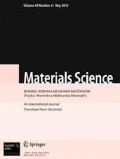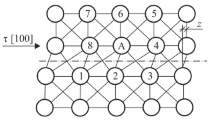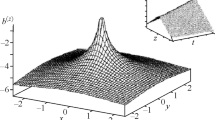We compare the dislocation model with a new discrete model of plasticity. According to the previously proposed model, a crystal lattice with spherically symmetric potential of interatomic interaction is unstable under shear stresses in the internal regions of the crystal. The surface layers preserve the unstable crystal lattice, which creates the state of unstable equilibrium in the crystal. As an important feature of the proposed model, we can mention the fact that the shift of atomic planes in the crystal occurs under low stresses in the absence of any defects, including dislocations. We also describe the advantages of the proposed model as compared with the dislocation model discovered in the course of analysis of the available experimental data.
Similar content being viewed by others
References
L. Yu. Kozak, “Plasticity and instability of crystal lattices,” Metalofiz. Noveish. Tekhnol.,34, No. 5, 1529−1545 (2012).
L. Kozak, “New atomic model of metals plastic deformation,” ASCIT J. Mater.,3, No. 5, 26–32 (2017); http://www.aascit.org/journal/archive?journalId=974&issueId=9740305.
L. Y. Kozak, “Investigation of the instability of crystal lattice by using discrete models,” Fiz.-Khim. Mekh. Mater.,53, No. 3, 118−123 (2017); English translation:Mater. Sci.,53, No. 3, 424−430 (2017); https://doi.org/https://doi.org/10.1007/s11003-017-0091-x).
L. Yu. Kozak, “Discrete models of plastic deformation of solids under the action of high hydrostatic pressure,” Fiz.-Khim. Mekh. Mater.,52, No. 1, 98−101 (2016); English translation:Mater. Sci.,52, No. 1, 108–112 (2016).
L. Yu. Kozak, “Discrete models of martensitic transformation and twinning in metals,” Fiz.-Khim. Mekh. Mater.,48, No. 5, 83−87 (2012); English translation:Mater. Sci.,48, No. 5, 647–652 (2013); https://doi.org/https://doi.org/10.1007/s11003-013-9550-1).
M. V. Klassen-Neklyudova and T. A. Kontorova, “On the dislocation hypothesis of plasticity,” Usp. Fiz. Nauk,11, No. 1, 143–151 (1954).
Ya. I. Frenkel’, An Introduction to the Theory of Metals [in Russian], Nauka, Leningrad (1972).
A. V. Stepanov, “On the dislocation theories of strength and plasticity of solids,” Zh. Tekh. Fiz.,23, No. 7, 1212–1218 (1953).
M. V. Bilous and M. P. Braun, Physics of Metals [in Russian], Vyshcha Shkola, Kiev (1986).
V. E. Panin, Structural Levels of Plastic Deformation and Fracture [in Russian], Nauka, Novosibirsk (1990).
V. I. Zasimchuk, E. É. Zasimchuk, and Yu. G. Gordienko, “Possible mechanism of formation of the nuclei of the channels of hydrodynamic plastic flow in crystals,” Metalofiz. Noveish. Tekhnol.,36, No. 4, 445–459 (2014).
E. A. Ivanova, “Mechanical properties of the crystal lattices and nanocrystals.” Access mode: http://www.ipme.ru/ipme/labs/dms/prive/ivanova/Home_page_Elena_Ivanova/Crystal%20lattices%20RUS.htm.
P. O. Esbjorn and E. J. Jensen, “Computer studies of dislocation properties using two-dimensional model systems,” J. Phys. Chem. Solids,37, No. 4, 1081–1091 (1976).
M. Born, “On the stability of crystal lattices,” Proc. Cambr. Phil. Soc.,36, No. 2, 160–172 (1940); doi: https://doi.org/https://doi.org/10.1017/S0305004100017138.
I. I. Novikov, Defects of the Crystal Structure of Metals [in Russian], Metallurgiya, Moscow (1975).
L. Yu. Kozak, Plasticity of Metals and Instability of Crystal Lattice [in Ukrainian], Fakel, Ivano-Frankivs’k (2004).
Z. Bojarski and Z. Wokulski, “Badania wiskerow zelaza w statycznej probie rozciagania,” Arch. Hutn.,3, No. 1, 3–26 (1980).
M. I. Gol’dshteini, V. S. Litvinov, and V. N. Bronfin, Metal Physics of High-Strength Alloys [in Russian], Metallurgiya, Moscow (1986).
S. Z. Bokshtein, S. T. Kishkin, M. P. Nazarova, and I. L. Svetlov, “Specific features of hardening of the metallic and nonmetallic filamentary single crystals,” in: Physics of Cold Hardening of Single Crystals [in Russian], Naukova Dumka, Kiev (1972), pp. 201–212.
G. V. Berezhkova, Filamentary Crystals [in Russian], Nauka, Moscow (1969).
A. M. Belikov, Plastic Deformation of Filamentary Crystals [in Russian], Izd. Voronezh Gos. Univ., Voronezh (1991).
V. I. Likhtman, P. A. Rehbinder, and G. V. Karpenko, Influence of Surface-Active Media on the Processes of Deformation of Metals [in Russian], Izd. Akad. Nauk SSSR, Moscow (1954).
L. I. Mirkin, Physical Foundations of Strength and Plasticity [in Russian], Mosk. Gos. Univ., Moscow (1968).
E. Schmidt and W. Boas, Plasticity of Crystals and, Especially, of Metallic Crystals [Russian translation], Inostr. Lit., Moscow (1938).
U. G. Bragg and U. L. Bragg, Crystalline State [Russian translation], NTI SSSR, Moscow (1938).
H. J. Gough, D. Hanson, and S. J. Wright, “The behaviour of single crystals of aluminium under static and repeated stresses,” Philos. Transact. Royal Soc.,226, 1–30 (1927).
F. R. N. Nabarro, Z. S. Bazinskii, and D. B. Kholt, Plasticity of Pure Monocrystals [in Russian], Metallurgiya, Moscow (1967).
G. P. Cherepanov, “On the general theory of fracture,” Fiz.-Khim. Mekh. Mater.,22, No. 1, 36–44 (1986).
V. P. Alekhin, Physics of the Strength and Plasticity of the Surface Layers of Materials [in Russian], Nauka, Moscow (1983).
M. A. Vasil’ev, Structure and Dynamics of the Surface of Transition Metals [in Russian], Naukova Dumka, Kiev (1988).
A. V. Bobylev, Mechanical and Technological Properties of Metals [in Russian], Metallurgiya, Moscow (1980).
V. I. Startsev, I. Ya. Il’ichev, and V. I. Pustovalov, Strength and Plasticity of Metals and Alloys at Low Temperatures [in Russian], Metallurgiya, Moscow (1975).
D. A. Wigley, Mechanical Properties of Materials at Low Temperatures, Plenum, New York (1971).
E. Yu. Tonkov, Phase Diagrams of Elements under High Pressures [in Russian], Nauka, Moscow (1979).
H. V. Karpenko, Physicochemical Mechanics of Metals [in Ukrainian], Naukova Dumka, Kyiv (1973).
G. A. Malygin, “Influence of hydrostatic pressure on the annihilation of screw dislocations by transverse sliding in alkali-haloid crystals,” Fiz. Tverd. Tela,34, No. 10, 3002–3010 (1992).
G. V. Samsonov, I. F. Pryadko, and L. F. Pryadko, Configuration Model of Substance [in Russian], Naukova Dumka, Kiev (1975).
B. I. Arkharov, Yu. G. Skripka, and E. S. Markhasin, “On the role played by the mechanism of formation of interatomic bonds in alloys in the formation of their strength and plastic properties,” Fiz.-Khim. Mekh. Mater.,14, No. 2, 47–50 (1978).
Ya. I. Dutchak, D. M. Freik, V. M. Chobanyuk, and M. O. Halushchak, Physics of Metals [in Ukrainian], NMK VO, Kyiv (1993).
W. B. Pearson, Crystal Chemistry and Physics of Metals and Alloys, Wiley, New York (1971).
R. W. Cahn, Physical Metallurgy [Russian translation], Mir, Moscow (1977).
C. Kittel, Introduction to Solid State Physics, Wiley, New York (1973).
R. Honeycomb, Plastic Deformation of Metals [Russian translation], Mir, Moscow (1972).
A. S. Тikhonov, Effect of Superplasticity of Metals and Alloys [in Russian], Nauka, Moscow (1972).
O. A. Kaibyshev, Superplasticity of Industrial Alloys [in Russian], Metallurgiya, Moscow (1984).
Author information
Authors and Affiliations
Corresponding author
Additional information
Translated from Fizyko-Khimichna Mekhanika Materialiv, Vol. 55, No. 4, pp. 7–14, July–August, 2019.
Rights and permissions
About this article
Cite this article
Kozak, L.Y. New Discrete Model of Plastic Deformation of Solid Bodies. Mater Sci 55, 461–468 (2020). https://doi.org/10.1007/s11003-020-00326-z
Received:
Published:
Issue Date:
DOI: https://doi.org/10.1007/s11003-020-00326-z




